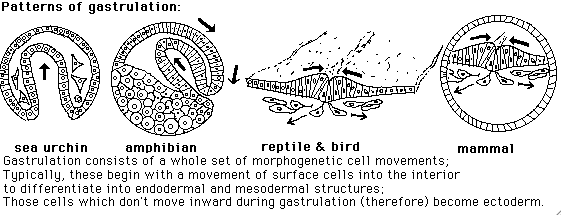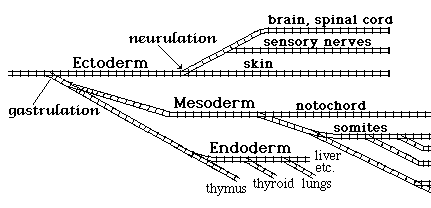Note: Gonads of both sexes develop from the same areas
of mesoderm in the lower back;
only in male mammals
are the testes moved from the back to the groin area.
The main theory is that this is to keep them cooler than body temperature,
because some unknown aspect of sperm differentiation can't occur if hot.
(guess where testes are in male birds!?)
* In males, stem cells continuously produce more sperm precursor cells.
Many millions of these cells begin meiosis every day.
These cells then quickly complete both meiotic divisions, before they begin their differentiation.
Differentiation of sperm is fairly rapid, completed in a few weeks
Sperm differentiation includes:
-
1# Shrinkage and reshaping of the nucleus
2# Inactivation of DNA, and refolding in smaller volume.
3# Growth of a long flagellum (in mammals and urchins)
4# Formation of a large lysosome, called the acrosome
5# Constriction and breaking away from 90+% of cytoplasm
Side issue: Sperm of many kinds of animals are very different from ours.
-
<> Salamander sperm have two flagella.
<> Nematode sperm have no flagella, and crawl by a special form of amoeboid locomotion that uses a special fibrous protein instead of actin!
<> Arthropod sperm (some species? all species??) have no flagella, neither swim nor crawl! They move passively!?)
<> Moss, fern and Ginko sperm (!) (What!? Some plants have sperm! What next?) each have dozens of flagella.
Back to important subjects!
-----------------------------------------------------------------------------------------------------------------------
** In female mammals, meiosis begins in all their oocytes during their own embryonic development.
(Holy cow! Is Development a crazy subject, or what? First fern sperm, and now this! What's next?)
[When Ron Paul becomes president, he will put a stop to such crazy facts!]
*** Oocytes don't finish their second meiotic division until after fertilization.
They don't even finish their first meiotic division until ovulation
(Which is the time when each oocyte is released from the ovary)
Therefore human embryos are triploid for a short period after fertilization!
("Triploid" means they have three complete sets of 23 chromosomes)
No wonder mistakes sometimes occur in separating chromosome pairs, and the new embryo is left with three copies of one chromosome, and two copies of all the other chromosomes. (this is called "trisomy")
|
An extra copy of the smallest chromosome (which is number 21, instead of #22)
causes the baby to have a condition that is generally called Down Syndrome in the US and Down's Syndrome in England. As you can find by looking at the Wikipedia article on Down syndrome and the comments posted on this article, many people feel very strongly that aposrophes should never be used when syndromes or diseases are named after the people who described them. The argument is that the physicians or scientists didn't have the disease themselves. For example they carry this to the extent of insisting that people should say and write "Alzheimer Disease," "Parkinson Disease" and "Non-Hodgin Lymphoma." Please don't tell them about "Nernst Equation", "Boltzman Constant", and "Maxwell Equations." Until about 30 years ago, Down Syndrome had been named "Mongolian Idiocy" (a term that can still be found in medical textooks), which sounds like it must have been meant as some kind of racial slur. This and other names like "Caucasoid Syndrome" had been chosen by a serious and sympathetic researcher, named Dr. Down, as part of what turned out to be a misguided attempt to make sense of various kinds of human birth defects. He did not mean these names as any kind of racial slur, nor were they interpreted that way, and you should remember that this was during a historical period when newspapers and politicians made very heavy use of real racial slurs.
|
|
For mothers beyond age 40, the frequency of Down Syndrome rises to 5% or more.
|
Dear Professor Harris,"This was too juicy to pass up." ... Samuel Spies, The News and ObserverI am appalled concerning your statement on aborting babies with Down Syndrome (as noted within your class notes from February 11, 2008):
As more and more people (including Americans - especially in Berkeley and Chapel Hill [Berkeley of the East]) believe that they are "God" and can say and do anything they want [including teach college students that abortion is a moral act and aborting children that have down syndrome is what mothers (of those babies) should do] then these words/actions show society how calloused some people, including UNC-CH professors, can really be.
Even though I believe that you will reject this request, I hope that you write a public apology to the UNC System family [including your students] and to the general public concerning your statements.
Sincerely compassionate,
Mark Prokop
St. Thomas More Catholic Church Respect Life Committee [Chapel Hill]
|
Article in the New York Times about prenatal testing : excerpt:
Others admit freely to a selfish motive for their new activism. "If all these people terminate babies with Down syndrome, there won't be programs, there won't be acceptance or tolerance," said Tracy Brown, 37, of Seattle, whose 2-year-old son, Maxford, has the condition. "I want opportunities for my son. I don't know if that's right or wrong, but I do." American College of Obstetrics and Gynecology recommendations on prenatal screening for Down syndrome
discussion of autosomal abnormalities
Down Syndrome: Health Issues National Down Syndrome Society Piedmont NC Down Syndrome support network
At least one fifth of human pregnancies end in spontaneous abortions (miscarriages); and the true percentage may be more than fifty percent. Trisomy for any of the larger chromosomes is fatal for the fetus or newborn baby.
|
|
Incidentally, chromosome numbers are assigned in descending order of size. In other words, chromosome number one is the biggest #2 is second biggest.
By mistake, the smallest human chromosome was named #21.
|
|
Another one of those boring side issues:
Until the mid 1960s, scientists thought there were 48 human chromosomes. The first "karyograms" were made using cells from a prisoner in a mental hospital, who seems to have had Down's Syndrome and also an extra Y chromosome. (In other words, cells were taken involuntarily from a mental patient, who really DID have two extra chromosomes. Apparently.) Then, for > fifty years, every researcher and clinician pretended to find those two extra dots on their slides; Understand, this happened millions of times and all over the world. Eventually, a Chinese-American researcher had the combination of skill, self-confidence and courage to publish the claim that everybody had been wrong, and the human diploid chromosome number is only 46. He deserves a statue to be built of him, and for me to remember his name. ------------------------------------------------------------------------------------------------ BLOCKS TO POLYSPERMY: Different methods to prevent any more sperm from fusing with the oocyte, after the first sperm has fused with it.
THE FAST BLOCK:
* A positive feedback cycles that opens sodium ion channels. (Reduces the voltage in the cytoplasm from minus 70 millivolts to ~zero.) * The oocyte plasma membrane won't fuse with any sperm when depolarized. * This depolarization also sets off all the slow blocks to polyspermy.
Which causes secretion of the > 10,000 cortical vesicles at the oocyte surface. THE SLOW BLOCKS:
Formation of the fertilization membrane Enzymes that cut the bonds of the oocyte surface to the vitelline membrane. (Which allows the fertilization membrane to lift away from the egg surface of sea urchin embryos; and allows frog and salamander eggs to rotate freely inside their jelly coatings, so that the white vegetal pole turns downward, and the black animal pole turns upward.
The knowledge above should also allow you to invent several new kinds of contraception, especially for sea urchins.
|
|
CLEAVAGE AND EARLY DEVELOPMENT: Most events in embryonic development evolve very conservatively.
Same tissues and organs develop from each germ layer; Some version of gastrulation and neurulation always occurs; And the same sets of signal molecules control these events…
Fish, reptiles, birds, and the most primitive mammals (Platypus & Echidna) have large, yolky eggs; Cleavage subdivides only a thin sheet of cells nearest the animal pole of the embryo. This is called "Meroblastic Cleavage" or "Meroblastic development", In contrast to "Holoblastic Cleavage", which occurs in (most!) sea urchins, all frogs and salamanders, a few fish, and humans and almost all mammals (except for the platypus, etc.). The cleavage furrows cut all the way through.
Nematodes also have holoblastic cleavage. The geometry of gastrulation is very different in meroblastic species, because it occurs in a flat sheet of cells, instead of a hollow ball of cells. AND (try to control your astonishment!) Mammal gastrulation is almost identical to bird and reptile gastrulation! This is because we are descended from reptiles! Our embryos cleave holoblastically to form a hollow ball, But then, instead of this hollow ball itself gastrulating (like a sea urchin) A flat sheet of cells forms across one side of the hollow ball, And then cells in this flat sheet gastrulate in the geometric pattern of a bird, etc. Using what is called the "Primitive Streak" pattern of gastrulation. One difference is that future mesoderm and endoderm cells move from the surface epithelium to the interior by ingression, instead of using invagination or involution to move to move below the surface. In other words, these cells temporarily convert from being epithelial to being mesenchymal in their behavior, shapes and interactions. +++++++++++++++++++++++++++++++++++++++++++++++++++
|



